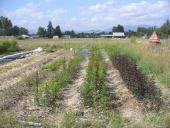








Growing on my small acre in SW USA; Fruit/Nut trees w/ annuals, Chickens, lamb, pigs; rabbits and in-laws onto property soon.
Long term goal - chairmaker, luthier, and stay-at-home farm dad. Check out my music! https://www.youtube.com/@Dustyandtheroadrunners




Dustin Rhodes wrote:Hello, welcome to the team Chris!
I have no experience in this, and am posting so that your thread gets a "bump."
Is there any way to find a thriving tree near you and digging some roots/soil without harming the tree? Then you could blend the roots, make a "tea" and inoculate with that, similar to a mushroom slurry?








Windy Huaman wrote:I thought it was debated whether or not C. Siliqua form root symbioses
Long lime ego, carob tree, like most legumes belong to Ceasalpinoideae subfamily, was considered to be not nodulate and unable to fix atmospheric nitrogen (Martins-Louçâo and Rodriguez-Barrueco, 1982; Martins-Loucâo, 1985). In 1996, Misbah et al. reported isolation and characterization on phenotypical features of the symbiotic bacteria associated with carob tree. Soon after, the activity of the enzyme nitrogenase was detected, in vitro culture, inside the carob roots and bourgeons (Byan et al. 1996). Therefore, the application of bioinoculant, platnt-growth promoting rhizobacteria (PGMR) such as endophytic bacteria Azospirillum, improved the performance of carob plants by nitrogen fixation by a mechanism other than nodulation (El-Refarey et al. 2011).




 . I will graft some fruiting wood onto this tree. The Sfax had a pod on it when purchased, so I have at least one confirmed female. I purchased these trees from Exotica nursery in Vista, California.
. I will graft some fruiting wood onto this tree. The Sfax had a pod on it when purchased, so I have at least one confirmed female. I purchased these trees from Exotica nursery in Vista, California.




Chris Wang wrote:Hi, I have been lurking on the forum for a few years and just joined.
I'm from Australia and I'm trying to find carob inoculant. I found an old thread where someone mentioned that it is/was available in Australia, but I cannot find any suppliers by searching the net.
Any help would be appreciated, thanks.
'Every time I learn something new, it pushes some old stuff out of my brain.'





F Agricola wrote:
Chris Wang wrote:Hi, I have been lurking on the forum for a few years and just joined.
I'm from Australia and I'm trying to find carob inoculant. I found an old thread where someone mentioned that it is/was available in Australia, but I cannot find any suppliers by searching the net.
Any help would be appreciated, thanks.
Try giving 'Daleys Fruit Tree Nursery' a call/email - they carry a huge variety of exotic trees and may know. They're located in northern NSW.
Failure is a sign of activity and learning. It had nothing to do with under achievement
I never want to have a team member who has never failed - They are not doing!! 👍

|
meow meow meow tiny ad meow meow
Support permies and give beautiful gifts to gardeners: permaculture playing cards.
https://gardener-gift.com/
|




